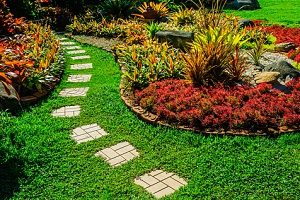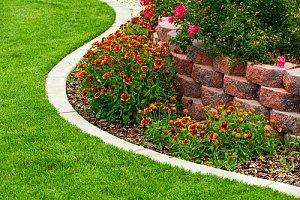 If you have noticed soil shifts on your Maryland property, you might be wondering how serious of a problem this is. Initially, the problems of soil shifting are going to be minor and cause small problems like sinkholes or ruined plants. But if this problem is left unchecked and gets worse, it could lead to costly problems. If you’ve noticed any of these problems in your yard, the best thing you can do is act quickly to keep the problem from getting worse. Soil shifts are most commonly due to water. If your yard is not able to properly drain its rainwater, the water can start to collect in unwanted places and begin to move the soil around. The best way to fix soil shifts is to actually add more dirt to your yard. You should utilize fill dirt for areas that need a lot of help, and use topsoil for areas that just need a little improvement.
If you have noticed soil shifts on your Maryland property, you might be wondering how serious of a problem this is. Initially, the problems of soil shifting are going to be minor and cause small problems like sinkholes or ruined plants. But if this problem is left unchecked and gets worse, it could lead to costly problems. If you’ve noticed any of these problems in your yard, the best thing you can do is act quickly to keep the problem from getting worse. Soil shifts are most commonly due to water. If your yard is not able to properly drain its rainwater, the water can start to collect in unwanted places and begin to move the soil around. The best way to fix soil shifts is to actually add more dirt to your yard. You should utilize fill dirt for areas that need a lot of help, and use topsoil for areas that just need a little improvement.
Identifying Soil Shifts
If you’re lucky, you’ll catch the soil shifts in the early and not very harmful stage. This is when you’ll notice changes to your yard’s appearance. If you begin to notice sinkholes, bare patches of grass, or plants that are shifting – you’ve got soil shifts. If the soil continues to shift and the problem is left unchecked, you are unfortunately going to start having problems with the foundation of your home. These can include things like diagonal cracks on interior walls at the corner of doors and windows, door binds and windows not opening or closing properly, floors are not level, cracked molding, etc. Identify soil shifts and taking care of them quickly is the best thing you can do.
What to Do
If your soil shifting is only affecting the appearance of your yard, for now, there’s no need to panic. There are a few simple things you can do to help improve the situation and prevent the soil shifting from affecting your house in any way. The first thing you want to do is pay careful attention to your yard and take note of how it deals with rainwater drainage. This is most likely what’s causing your soil to move. If the water happens to be draining towards your house, you’re going to need to do some land grading and sloping to redirect the water flow away.
 Start off by finding the high point and the low point of your drainage problem. The high point is where the water is flowing in the wrong direction. For example, if the land slopes down in the direction of your house, the high point is going to be the very top of the slope. The low point is where the water is pooling, so it would be the very bottom of the slope. If your yard is relatively flat, it may be hard for you to determine these spots right away. Wait for a rainstorm that creates water flow in your yard. When the rainstorm is over, walk around your yard and take note of where the water is pooling. This can be done sticking a stake or other marker into the ground. Wait an hour and then check the points you have marked again. If the standing water is still there, then this is a low point in your yard where the water is draining to.
Start off by finding the high point and the low point of your drainage problem. The high point is where the water is flowing in the wrong direction. For example, if the land slopes down in the direction of your house, the high point is going to be the very top of the slope. The low point is where the water is pooling, so it would be the very bottom of the slope. If your yard is relatively flat, it may be hard for you to determine these spots right away. Wait for a rainstorm that creates water flow in your yard. When the rainstorm is over, walk around your yard and take note of where the water is pooling. This can be done sticking a stake or other marker into the ground. Wait an hour and then check the points you have marked again. If the standing water is still there, then this is a low point in your yard where the water is draining to.
To fix this problem you need to place enough fill dirt in the low point to make it level with the high point. The fill dirt that has been placed will change the level of the slope and prevent water from pooling where you don’t want it to.
You could also build a swale to move the water from its unwanted location. A swale is a shallow trench that is dug out completely level along the land’s contour with a berm on the downhill side. Swales are great if you’re looking to make your yard earth-friendly because they help to not overwhelm the sewer systems. This is because they slow, store and spread stormwater. If you are a gardener, you could even construct it to have the water flow into rain barrels which will allow you to water your plants during dry spells.
When constructing a swale, it’s important to remember that the goal of managing rainwater is to hold it as high in the landscape as possible. This will create maximum efficiency and absorption. The swale will catch the water and prevent it from reaching your house by redirecting it, and by absorbing it deep into the soil. Building a swale is relatively simple and only requires some fill dirt to help you. Once you’ve selected the ideal location for your swale, dig out a trench in the direction you want to the water to run. Then using fill dirt, build up one side of the swale to create a berm that will prevent the water from escaping the swale.
While fill dirt can correct the major problems in your yard, you may find topsoil to be more suitable in areas that don’t have serious slope problems. To address this, utilize a sandy soil combined with organic matter (like compost or ground pine bark) and mix it in with the existing dirt to a depth of about 12 inches. Changing the composition of your current dirt will allow water to drain far more successfully to avoid creating any unwanted puddles in your yard. This is one of the more forgotten uses for topsoil and can prevent serious damage to the foundation of your home.
Schedule Your Fill Dirt Delivery
 You should also target any areas of your yard that are bald spots. Not only are these undesirable looking, but because the soil is exposed it is much easier for it to shift. For most people, this means growing grass and plants. These plants will grow roots that dig deep into the ground and help prevent the dirt from going anywhere, even in heavy rain. Topsoil and fill dirt can be instrumental in solving the soil shifting problem your Maryland property is having. Be sure to reach out to a Maryland fill dirt contractor for more information and to schedule your Maryland fill dirt delivery.
You should also target any areas of your yard that are bald spots. Not only are these undesirable looking, but because the soil is exposed it is much easier for it to shift. For most people, this means growing grass and plants. These plants will grow roots that dig deep into the ground and help prevent the dirt from going anywhere, even in heavy rain. Topsoil and fill dirt can be instrumental in solving the soil shifting problem your Maryland property is having. Be sure to reach out to a Maryland fill dirt contractor for more information and to schedule your Maryland fill dirt delivery.









































